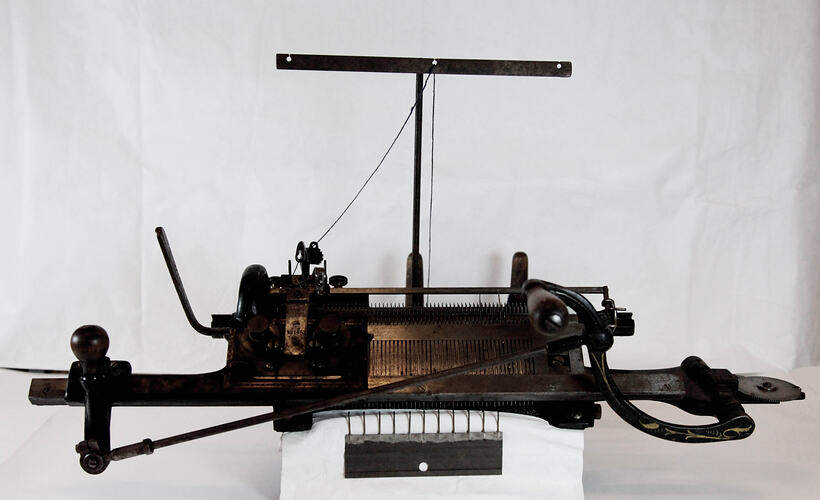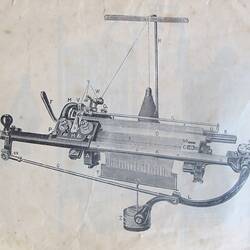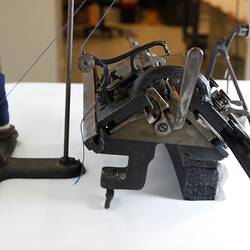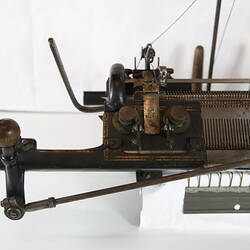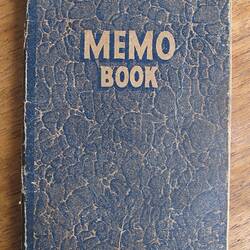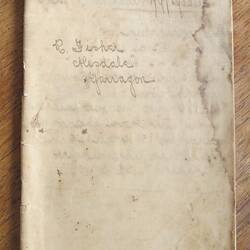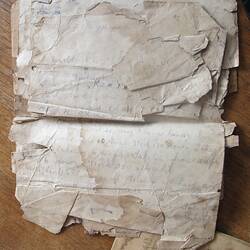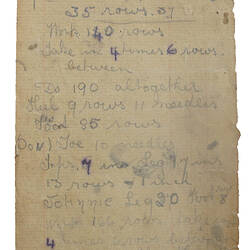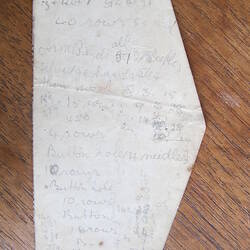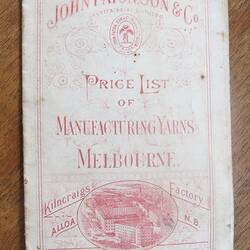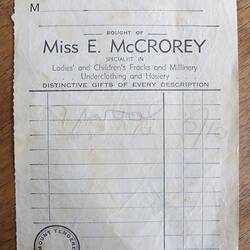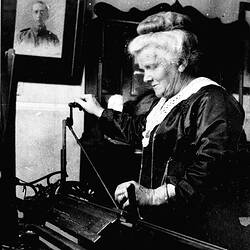Summary
Hand-operated and hand-powered flat-bed 'Preciosa' knitting machine manufactured by Wertheim (Germany) and retailed in Melbourne by Hugo Wertheim. The collection includes spare needles, tools, spare parts, original receipts, instruction books, a photograph of the donor wearing a dress knitted using this machine, two samples of knitted work, hand-written patterns and other users' notes. Its handbook describes the machine as a 'family knitting machine'.
The knitting machine was purchased by the donor's grandmother, Ruby Fisher (1890-1958), from Hugo Wertheim in Bourke Street, Melbourne, in 1910.
Ruby was a talented pianist who lived on a farm, 'Alisdale', in Yaragon, Gippsland, one of 11 children. She purchased the knitting machine when aged around 20, for the then considerable sum of 10 pounds 15 shillings. In its early years Ruby used the machine to make a range of items on commission, including boys' long socks, 'ladies stockings', 'socklets', 'jumper bands', singlets, neck and arm bands and even 'button holes'. She also made more complicated cardigans and jumpers. One of her notebooks lists items ordered and by whom, and what she charged - usually between two and five shillings per order. Her stamp appears in some of the notebooks: 'R. FISHER KNITTER' and 'ALISDALE YARRAGON'.
The machine was also used to knit socks for soldiers during World War I - according to the donor, a record 23 pairs of socks were knitted in a single day! Hand-written patterns for 'Soldiers Long Sox 3 ply' 'Soldier's Stocking' are included in the collection. The machine was probably also used to knit for World War II soldiers.
Ruby married Tom Richards in 1914. Tom was from Prahran, and ran a produce store there with his sisters. He sold his share in the business when he married Ruby, and they used the money to buy a farm outside Traralgon, which remains in family hands to this day. They had a son and daughter 10 years apart - their daughter Jean is the donor's mother. Jean used the machine for many years, including making clothing for her daughter Raema, the donor. Raema recalls not liking the shoulders on the garments made by the machine, which had a bulky finish.
Hugo Wertheim (1854-1919) was born in Germany and arrived in Melbourne, Australia in 1875. He set himself up as an agent for his father's cousin Joseph Wertheim, a well-established manufacturer of sewing machines. He imported pianos and bicycles as well as sewing and knitting machines, selling them under brands such as Wertheim, Electra, Planet, Griffin and Hapsburg. In 1908 he became the first Victorian piano manufacturer when he opened a large factory in Richmond. He passed away in 1919, but the business continued in family hands. (The sewing machine manufacturer Wertheim was founded in Germany in 1868 by Joseph Wertheim. Wertheim was also the name of a large department store chain in pre-World War II Germany, established by Georg Wertheim.)
The model name or manufacturer of the machine is not obvious, but is deduced from the body text of an instruction manual accompanying the machine. This is further confirmed by contemporary newspaper advertisements illustrating the Wertheim 'Preciosa' - although these show it mounted on a floor stand, whereas this example can be screwed onto a 'firm table'.
Physical Description
The collection comprises: cast metal-framed knitting machine photograph of donor as a toddler (digital acquisition) in an outfit knitted by the machine two tins and one cardboard box of parts winding handle for yarn two-bobbin winder metal plate to attach machine to bench set of four weights on a weight carrier and 1 drop-shaped weight five hand-written booklets several loose notes two instruction books Wertheim price list two purchase receipts brush sock fingerless mitten
Significance
Statement of significance:
The knitting machine provides a relatively rare record of a woman's cottage industry in rural Victoria in the early 20th century, as well as being a significant item of material culture relating to work for the war effort on the home front during World Wars I and II. The machine collection includes a range of parts, manuals, users' notes, two garments and a (digital copy of a) photograph of a garment being worn, providing a comprehensive record of how the machine was used and for what purposes, and how this changed over time as a second user worked the machine.
Knitting machines were enthusiastically advertised in the media in the early 20th century when this model was purchased, both for making family clothing and as a means of earning money. Hugo Wertheim advertised knitting machines as 'One of the most profitable means by which to earn a livelihood or supplement an income IN YOUR OWN HOME' (The Age, 4/2/1911, page 2).
The first hand-powered flat-bed knitting machine was invented by the American William Isaac Lamb in 1863. The machine enabled rapid production of tube and rib-knitted fabric. It knitted in alternating plain and pearl stitches, providing a ribbed effect with high elasticity that looked the same on both sides. The year after its invention, Lamb's flat-bed knitting machine was improved by another American, Henry J. Griswold. Sold under the names 'Climax', 'Crane' and 'Little Rapid', the machines were used in the cottage industry to make men's socks and children's stockings. With further improvements in the machine's design, circular-knit stockings could also be made.
In Europe, manufacturer Henri Eduard Dubied saw the flat-bed machine displayed at the World Expo in Paris in 1867. He bought the patent and began to make the machines, which he called the 'Trikoteuse Omnibus', in his own Swiss factory. By the end of the decade French and German manufacturers, including Laue und Timaeus (later Irmscher & Co., Dresden) were also making flat-bed machines. In 1888 the invention of the tubular cam by G. F. Grosser in Markersdorf allowed heels to also be knitted by the flat-bed machines. Later developments facilitated the production of patterned goods and the use of an electric motor. The Lamb Corporation remains in business to this day.
More Information
-
Collecting Areas
Working Life & Trades, Sustainable Futures, Public Life & Institutions, Clothing & Textiles
-
Acquisition Information
Donation from Raema Edgington
-
Date Purchased
-
Retailer
Hugo Wertheim, 294-296 Bourke Street, Melbourne, Victoria, Australia, 1910
-
Purchaser of Item Depicted
Ruby Fisher, 294-296 Bourke Street, Melbourne, Victoria, Australia, 1910
-
Inscriptions
Extensive
-
Classification
-
Category
-
Discipline
-
Type of item
-
References
German Hosiery Museum, [Link 1] accessed 14/6/2012 Wonseok Choi, 'Three Dimensional Seamless Garment Knitting on V-Bed Flat Knitting Machines', Journal of Textile and Apparel, Technology and Management, vol.4, no.3, Spring 2005 Alex L. Askariffm Sewalot web site [Link 2] accessed 15/6/2012 'Hugo Wertheim', Australian Dictionary of Biography, [Link 3] accessed 15/6/2012
-
Keywords
Handcrafts, World War I, 1914-1918, World War II, 1939-1945, Manufacturing, Home Workers, Work in the Home, Knitting Machines, Knitting Patterns, Rural Life, Rural Women, Domestic Work, Soldiers' Comforts
